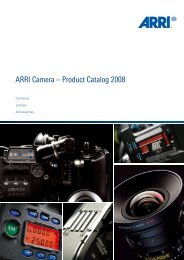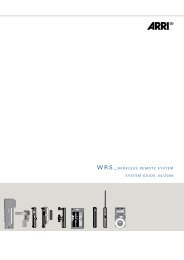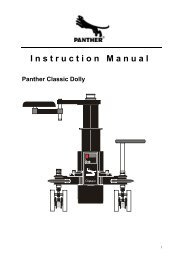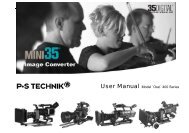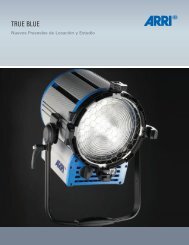ALEXA Studio Electronic and Mirror Shutter
ALEXA Studio Electronic and Mirror Shutter
ALEXA Studio Electronic and Mirror Shutter
Create successful ePaper yourself
Turn your PDF publications into a flip-book with our unique Google optimized e-Paper software.
<strong>Mirror</strong> <strong>Shutter</strong> Basics<br />
A mirror shutter is a mirror, located at an angle in front of the sensor, that continuously rotates. Half the time it<br />
reflects light up into the optical viewfinder <strong>and</strong> the other half it lets light fall onto the sensor. Thereby the mirror<br />
shutter makes the optical viewfinder possible <strong>and</strong> determines the exposure.<br />
VIEW <strong>and</strong> GATE Phases<br />
When running, half the time the mirror covers the sensor <strong>and</strong> reflects the light from the lens onto the ground<br />
glass, where an image forms. The optical viewfinder magnifies this image. This is called the VIEW phase. Thus<br />
the camera operator can literally see through the lens.<br />
The other half of the time the mirror shutter reveals the sensor which exposes the photosites to light from the<br />
lens. However, no light reaches the optical viewfinder. This is called the GATE phase. GATE is a term derived<br />
from the open aperture behind which the film is located on film cameras.<br />
The Open <strong>Shutter</strong> Angle<br />
The open half of the mirror shutter is generally referred to as<br />
the shutter angle. The largest possible open shutter angle is<br />
180º. The shutter angle can be reduced by means of a thin<br />
carbon blade that is situated behind the mirror <strong>and</strong> can be<br />
extended to fill the previously open space. Thus the open<br />
angle can be reduced from 180º to 11.2º.<br />
Advantages of Optical Viewfinders<br />
An optical viewfinder offers the most comfortable, accurate<br />
<strong>and</strong> efficient operating experience. Optical viewfinders have<br />
zero delay <strong>and</strong> show a bright <strong>and</strong> sharp full color image<br />
through the taking lens. Since they exhibit no motion blur,<br />
judging focus during movement is easy. They show natural<br />
motion portrayal, accurate color fidelity <strong>and</strong> proper white<br />
balance, i.e. that of the scene. Operators see exactly what is<br />
happening as it happens <strong>and</strong> experience less eye fatigue.<br />
Cinematographers appreciate the ability to judge lighting<br />
through the viewfinder <strong>and</strong> to work with the camera even<br />
when it is powered down since choosing lenses, blocking,<br />
setting up shots, pre-lighting or rehearsing before the<br />
camera is powered up can save precious time on the set.<br />
<strong>ALEXA</strong> <strong>Studio</strong> <strong>Electronic</strong> <strong>and</strong> <strong>Mirror</strong> <strong>Shutter</strong> White Paper Page 3 of 9



